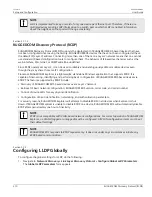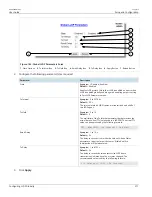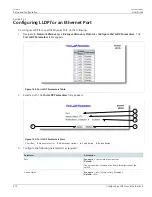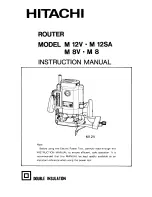
Chapter 5
Setup and Configuration
RUGGEDCOM ROS
User Guide
224
Managing GMRP
Parameter
Description
NOTE
This parameter also affects the Group Membership
Interval (i.e. the group subscriber aging time),
therefore, it takes effect even in PASSIVE mode.
Router Ports
Synopsis:
Comma-separated list of ports
Default:
None
This parameter specifies ports that connect to multicast routers. If
you do not configure known router ports, the switch may be able
to detect them, however it is advisable to pre-configure them.
Router Forwarding
Synopsis:
{ Off, On }
Default:
On
This parameter specifies whether multicast streams will be always
forwarded to multicast routers.
RSTP Flooding
Synopsis:
{ Off, On }
Default:
Off
This parameter specifies whether multicast streams will be
flooded out of all RSTP non-edge ports upon topology change
detection. Such flooding is desirable, if guaranteed multicast
stream delivery after topology change is most important.
4. Click
Apply
.
Section 5.8.2
Managing GMRP
The GMRP is an application of the Generic Attribute Registration Protocol (GARP) that provides a Layer 2
mechanism for managing multicast group memberships in a bridged Layer 2 network. It allows Ethernet switches
and end stations to register and unregister membership in multicast groups with other switches on a LAN, and for
that information to be disseminated to all switches in the LAN that support Extended Filtering Services.
GMRP is an industry-standard protocol first defined in IEEE 802.1D-1998 and extended in IEEE 802.1Q-2005. GARP
was defined in IEEE 802.1D-1998 and updated in 802.1D-2004.
NOTE
GMRP provides similar functionality at Layer 2 to what IGMP provides at Layer 3.
CONTENTS
•
Section 5.8.2.1, “GMRP Concepts”
•
Section 5.8.2.2, “Viewing a Summary of Multicast Groups”
•
Section 5.8.2.3, “Configuring GMRP Globally”
•
Section 5.8.2.4, “Configuring GMRP for Specific Ethernet Ports”
•
Section 5.8.2.5, “Viewing a List of Static Multicast Groups”
•
















































